This guide shows you how to fix blue screen of death errors (or BSoD errors) for Windows XP.
Contents
If you see a blue screen error, but Windows XP restarts immediately and you can’t read the error text, follow these instructions to disable the Automatically restart option:
- Right-click on My Computer
- Go to Properties
- Go to the Advanced tab
- At the Startup and Recovery section, click the Settings button
- At the System failure section, make sure the “Automatically restart” option is unchecked
- Click OK
If you can’t boot into Windows, try booting into Safe Mode, follow the instructions above and then restart your computer again. To boot Windows XP in Safe Mode, follow these steps:
- Restart your computer
- Press F8 before the Windows logo appears
- Use the arrow keys and select “Safe Mode” from the boot menu
- Press Enter
0x000000ED (UNMOUNTABLE BOOT VOLUME)

The 0x000000ED blue screen error code is most commonly known as UNMOUNTABLE_BOOT_VOLUME. We covered how to fix UNMOUNTABLE_BOOT_VOLUME in Windows XP already.
For situations where the UNMOUNTABLE_BOOT_VOLUME error is caused by incorrect or outdated information regarding the Windows partition in the boot configuration files (BOOT.INI or the BCD) for NTLDR or BootMGR, Easy Recovery Essentials can normally recreate the boot configuration with the correct settings and parameters to allow for Windows to boot correctly:
- Download Easy Recovery Essentials from here. Choose your Windows version (XP, Vista, 7 or 8) before you go to download
- Burn the image. Follow these instructions on how to burn the bootable ISO image very carefully, as making a bootable CD can be tricky!
- Boot into Easy Recovery Essentials
- Choose Automated Repair option and click Continue
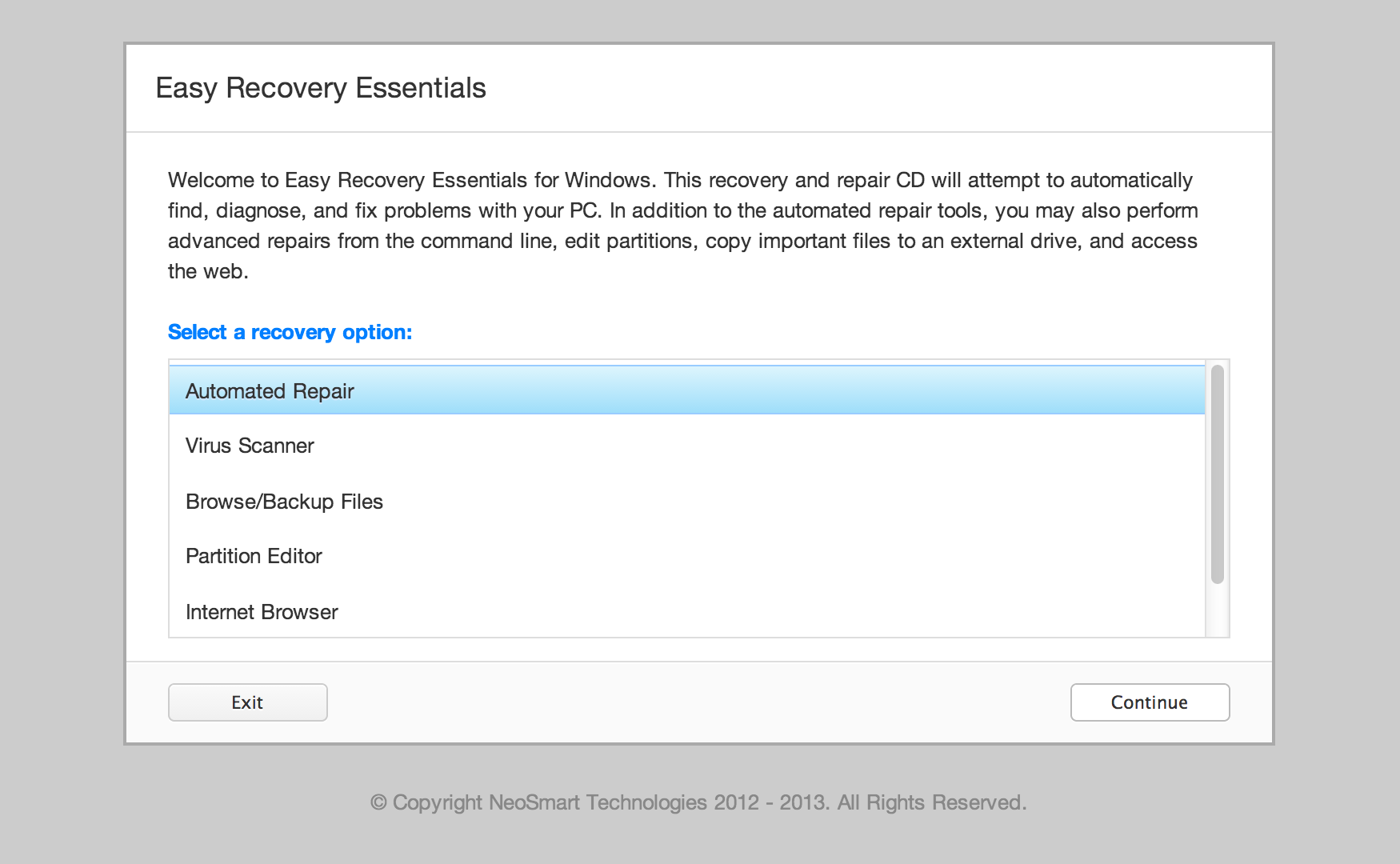
- Choose your Windows installation drive’s letter (usually C:\) and click Automated Repair
- Wait for Easy Recovery Essentials to complete the process
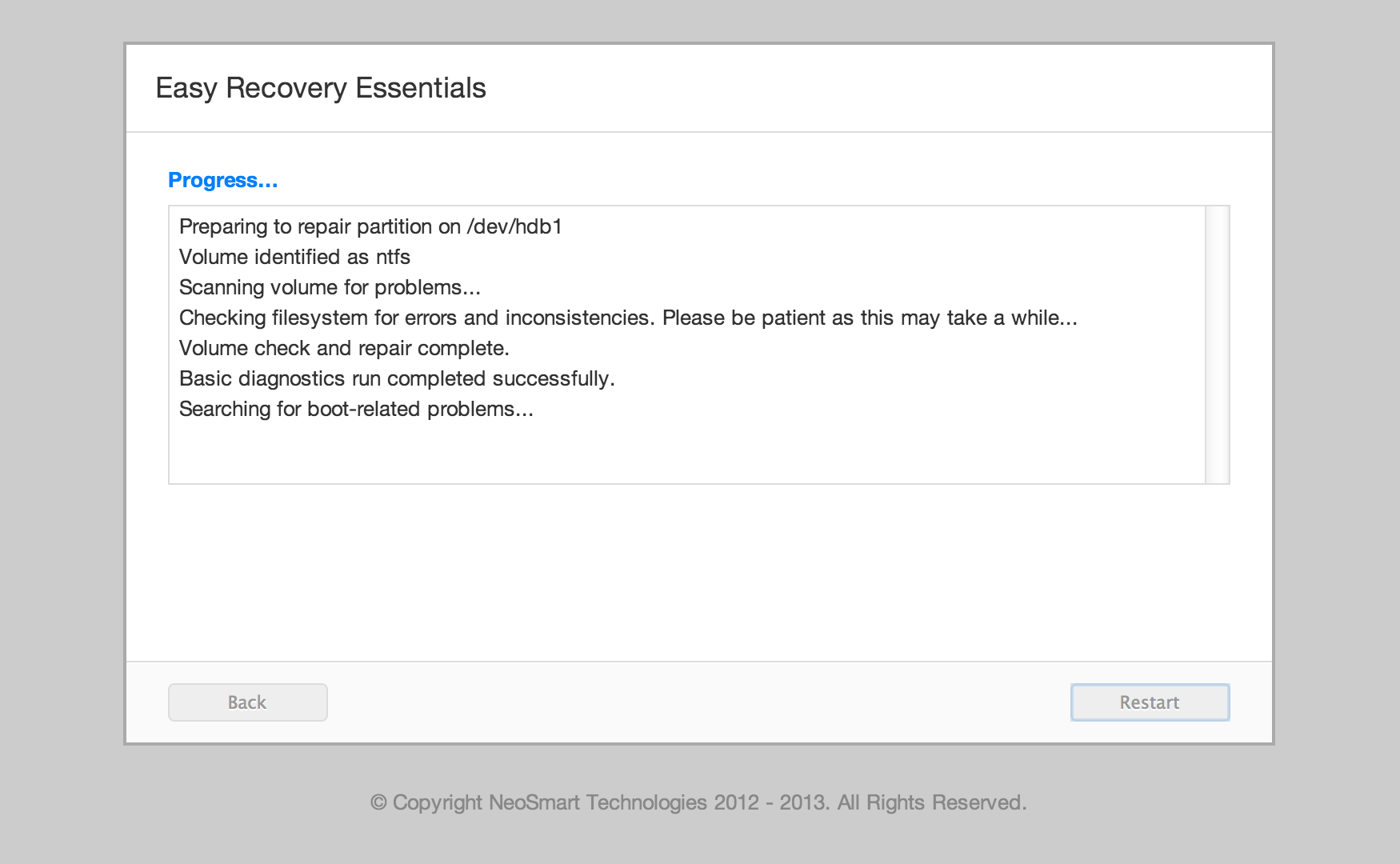
- Once the process is complete, click Restart
0x0000007B (INACCESSIBLE BOOT DEVICE)
The blue screen error 0x0000007B has the name INACCESSIBLE_BOOT_DEVICE.
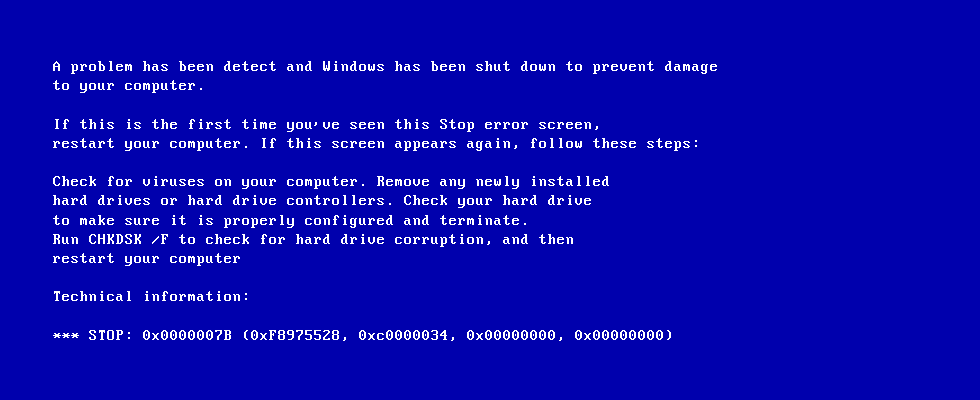
This error appears if your computer is infected a boot-sector virus, there is an issue with a device driver or an issue with a piece of hardware. Other issues may also cause this error to show up.
Follow these instructions to fix this error in Windows XP:
Fix #1: Remove viruses
If your computer is infected with a boot-sector virus, run an antivirus scan and remove all viruses from your computer to possibly fix the error.
If you don’t have an antivirus scanner, use the Virus Scanner of our recovery disk Easy Recovery Essentials that you can burn to any CDs, DVDs or USBs and run the scan:
- Download Easy Recovery Essentials from here
- Burn the image. Follow these instructions on how to burn the bootable ISO image very carefully, as making a bootable CD can be tricky.
- Boot Easy Recovery Essentials
- Choose Virus Scanner

- Wait for the scan to complete

Fix #2: Run chkdsk
You can run the chkdsk command to check if the boot volume is corrupted. To do so:
- Insert the original Windows XP installation disk
- Boot from the CD. Press any key when the “Press any key to boot from CD” message appears
- Press R to open Recovery Console
- Type in the administrator password and hit Enter
- Press Enter
- Restart your computer
When Command Prompt has loaded, type the following command:
chkdsk /r
Fix #3: Recover the Windows XP registry
Follow the instructions from the Windows could not start: CONFIG\SYSTEM error guide on how to recover the registry of a Windows XP system.
The instructions mentioned there are the same you need to perform for the 0x0000007B error.
Fix #4: Check or remove hardware
If you installed a new hardware piece, remove it and restart your computer.
Check that all hard disk cables are connected properly.
Fix #5: Reboot into Last Known Good Configuration
The Last Known Good Configuration mode can solve issues caused by an incorrect or misconfigured driver. This Windows mode forces your computer to use a previously saved version of the Windows registry.
To do so, follow these steps:
- Restart your computer
- Start tapping F8 repeatedly before the Windows XP logo appears, but after the BIOS screen (the screen with your manufacturer logo and/or system information)
- When the boot options list screen appears, choose “Last Known Good Configuration (Advanced)”
- Press Enter
Fix #6: Reconfigure the boot.ini
A misconfigured boot.ini can be the cause for the 0x0000007B error.
To rebuild the boot.ini using Easy Recovery Essentials, follow the instructions:
- Download Easy Recovery Essentials from here. Choose your Windows version (XP, Vista, 7 or 8) before you go to download
- Burn the image. Follow these instructions on how to burn the bootable ISO image very carefully, as making a bootable CD can be tricky!
- Boot into Easy Recovery Essentials
- Choose Automated Repair option and click Continue

- Choose your Windows installation drive’s letter (usually C:\) and click Automated Repair
- Wait for Easy Recovery Essentials to complete the process

- Once the process is complete, click Restart
0x00000024 (NTFS FILE SYSTEM)
A blue screen error with the error code as 0x00000024 indicates an issue with the NTFS file system. This is usually caused by data corruption on your hard disk.
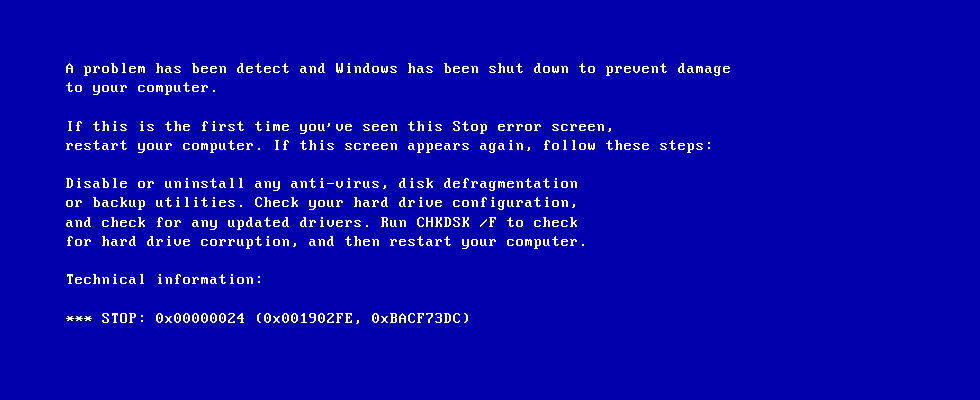
To fix this error try the following methods:
Method #1: Check or remove hardware
Make sure that all disk cables are connected properly before booting your computer. If you installed new hardware, try to remove it and restart your computer to see if the error appears again.
Method #2: Run the chkdsk command
The chkdsk utility, available on your Windows XP installation CD can detect and potentially fix corrupted data.
- Insert and boot from the CD
- Press R to go to the Recovery Console
- Type in the administrator password
- Hit Enter
- Type the following command, in Command Prompt:
chkdsk /f /r
- Press Enter
- Restart
More information about this error is available in the “Fix 0x00000024” guide.
If the above methods do not work, try reinstalling Windows XP or replace the hard disk.
0x0000007E (SYSTEM THREAD EXCEPTION NOT HANDLED)
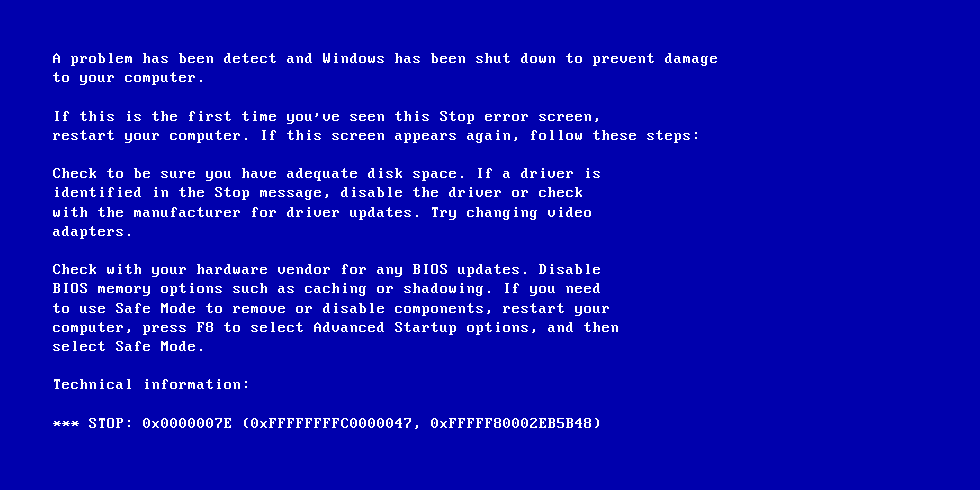
The 0x0000007E error
A blue screen error with the code as “0x0000007E” (SYSTEM_THREAD_EXCEPTION_NOT_HANDLED) can be caused by any of the following:
- Insufficient hard disk space
- Your BIOS might be incompatible with Windows XP
- The video adapter driver isn’t compatible with Windows XP
- The device drive is misconfigured or damaged
- Issues with the “Win32k.sys” file
Try these tips to fix this error:
- Make sure you have enough hard disk space. It’s very common for the 0x0000007E error to appear because of insufficient space on the disk.
- Try updating your BIOS software. Contact or search your computer manufacturer’s website on how to update BIOS.
- Temporarily remove any drivers you recently installed. Remove any unsigned drivers (not digitally signed by Microsoft) if the cause isn’t any of the recently installed drivers.
0x0000008E (KERNEL MODE EXCEPTION NOT HANDLED)
The blue screen error with “0x0000008E” as the error code and “KERNEL_MODE_EXCEPTION_NOT_HANDLED” as the error name (not necessarily displayed) can be caused by a RAM memory module that is faulty or incompatible with Windows XP.
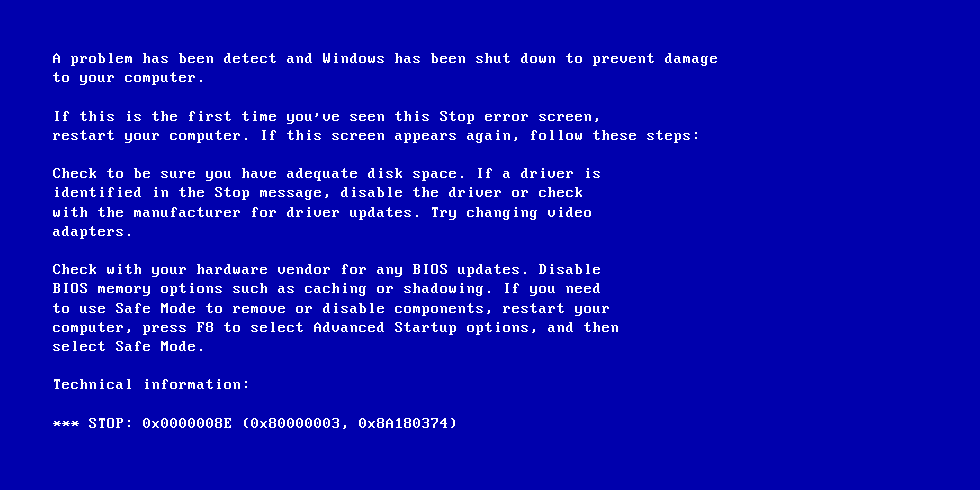
To fix this error, try these methods:
Method #1: Remove new RAM modules
Remove any RAM modules you’ve recently added to your system. Then, restart your computer and try again.
Method #2: Uninstall new software or drivers
If 0x0000008E appeared after installing a new piece of software or a device driver, try removing the software and restart your system to see if the error disappears.
Method #3: Update BIOS
Search on your computer manufacturer’s website on how to update your BIOS.
0x00000050 (PAGE FAULT IN NONPAGE AREA)
The blue screen error with the code “0x00000050” (PAGE_FAULT_IN_NONPAGED_AREA) can be caused by corrupted data on the hard disk, incompatibility of the installed display adapter drivers with Windows XP, or other causes.
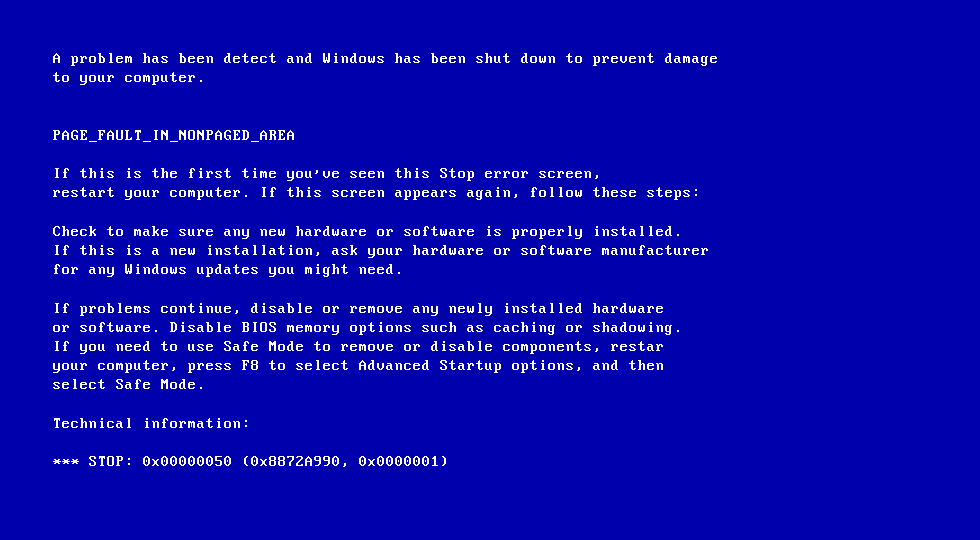
To repair your computer from this error, try the following fixes:
Fix #1: Boot into the Last Known Good Configuration mode
The Last Known Good Configuration mode can solve issues caused by an incorrect or misconfigured driver. To boot into this mode, follow these steps:
- Restart your computer
- Press F8 repeatedly before the Windows XP logo appears
- Choose “Last Known Good Configuration (Advanced)” from the boot options menu
- Press Enter
Fix #2: Remove any new installed software or drivers
If the error showed up after you installed a new software or a device driver, remove it from your system and try again.
Fix #3: Check the hard disk cables
Make sure all your hard disk cables are connected properly.
0x000000D1 (DRIVER IRQL NOT LESS THAN OR EQUAL TO)
The blue screen error with the code “0x000000D1” and name as “DRIVER_IRQL_NOT_LESS_THAN_OR_EQUAL_TO” can be caused by a faulty driver.
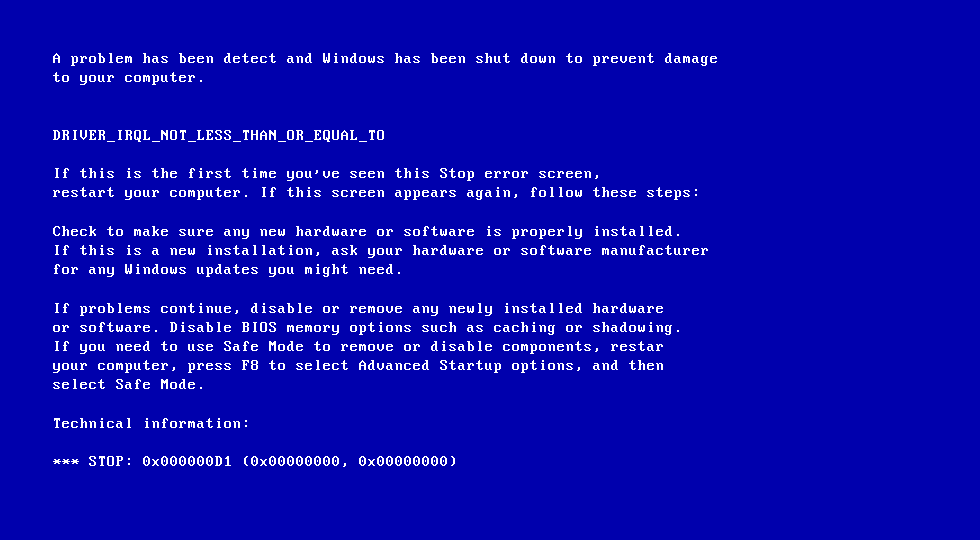
Microsoft released an update for Windows XP Service Pack 2 (SP2) users that have the 0x000000D1 error:
Follow the instructions from the “Install Instructions” section on how to install the update.
If #KB916595 doesn’t fix the error, try uninstalling any new device drivers you may recently installed on your system.
0xC0000218
The blue screen error with the code “0xC0000218” (sometimes with these names displayed along: STATUS_CANNOT_LOAD_REGISTRY_FILE, UNKNOWN_HARD_ERROR, {Registry File Failure}) is caused by a misconfigured registry (a registry hive file can’t be loaded properly).
A hive is a group of keys (and subkeys) and values in the registry.
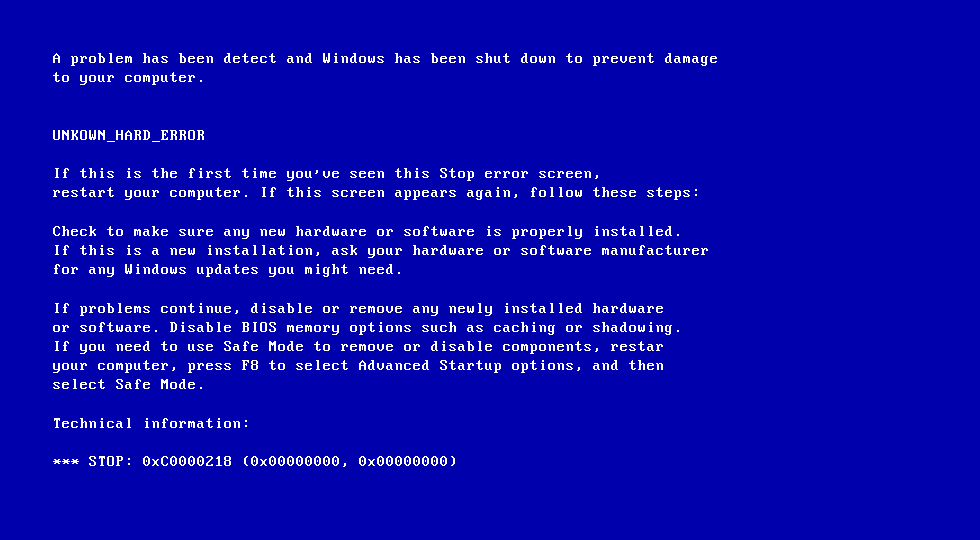
You can fix the 0xC0000218 error by trying any of the following methods covered below:
Method #1: Run the chkdsk /p command
You need your original installation CD for this procedure. When you have the CD ready, follow these steps:
- Insert the CD
- Boot into the CD
- Press R for Recovery Console
- Type in the administrator password
- Hit Enter
- Type the following command in Command Prompt:
chkdsk /p
- Press Enter
- Restart
Method #2: Boot to the Last Known Good Configuration
You can boot into Windows XP’s Last Known Good Configuration mode by doing these steps:
- Restart your computer
- Press F8 repeatedly before the Windows XP logo appears
- Choose “Last Known Good Configuration (Advanced)”
- Press Enter
Method #3: Recover the registry
Follow the instructions from the Windows could not start: CONFIG\SYSTEM error guide on how to recover the registry of a Windows XP system.
0x000000EA (THREAD STUCK IN DEVICE DRIVER)
The blue screen error with the code “0x000000EA” and the name “THREAD_STUCK_IN_DEVICE_DRIVER” that a video card driver (most likely) is stuck in a loop.
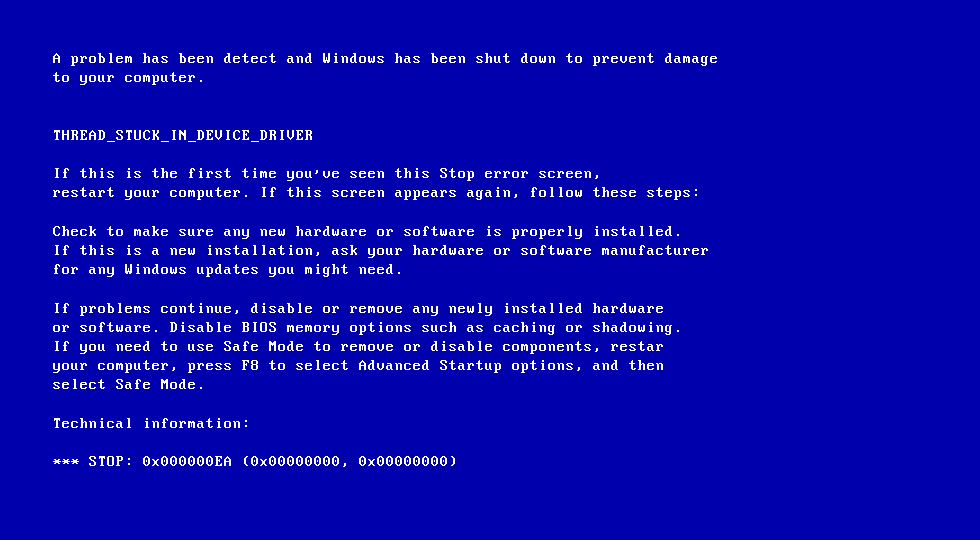
To fix this error, try any of the following fixes.
Fix #1: Install the latest driver
Make sure your video adapter has the latest driver available installed. If it’s not, remove the current driver, restart your computer, install the latest driver available from the manufacturer’s website and then restart your computer again.
Fix #2: Adjust Hardware Acceleration
To adjust the acceleration, follow these steps:
- Click Start
- Click Control Panel
- Click Display
- At the Settings tab, click Advanced and then click on the Troubleshoot tab
- Move the Hardware Acceleration slider to None
- Click the Enable write combining option to make it unchecked
- Click OK
- Click OK again
More Information
Linked Entries
Support Links
- Easy Recovery Essentials for Windows – our repair and recovery disk.
It’s an easy-to-use and automated diagnostics disk. It’s available for Windows 8, Windows 7 and Windows Vista. It’s also available for Windows XP and Windows Server.Read more at Windows Recovery Disks.
- The NeoSmart Support Forums, member-to-member technical support and troubleshooting.
- Get a discounted price on replacement setup and installation discs: Windows XP.
Applicable Systems
This Windows-related knowledgebase article applies to the following operating systems:
- Windows XP (all editions)